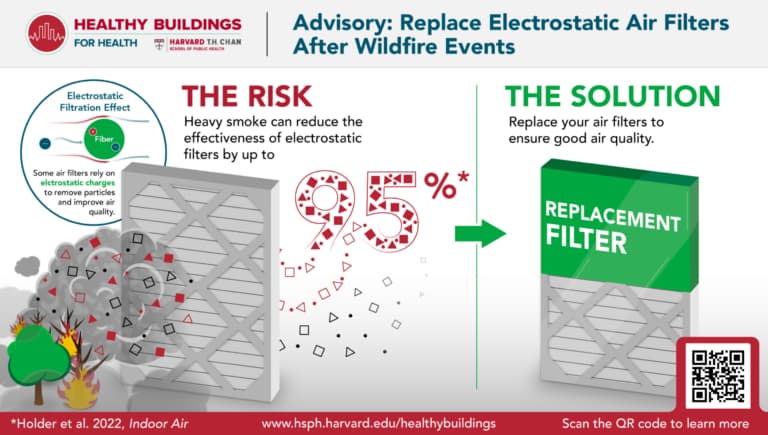August 8 marks the one-year anniversary of the Lahaina wildfires, which caused devastating loss of life, community, and homes. Researchers in Hawaii and across the U.S. have been working to understand the ongoing environmental and health impacts of the wildfires.
The Harvard Healthy Buildings Program is one of those teams. In partnership with local community members and researchers at the University of Hawaii at Manoa, we have been collecting air samples in homes adjacent to the wildfires as part of work funded by the National Science Foundation (NSF).
Air Quality Reports for Homes
Our first priority is to inform residents about the results we found in their homes so they can take steps to enhance air quality and safeguard their health.

All participants in our study have now received confidential reports that describe the levels in their homes, along with information to help interpret those levels. The report also includes tips for reducing exposure and resources for more information.
For each pollutant measured, we provided residents with information about what each pollutant is, common sources, potential health effects, and three points of reference to help interpret the levels we measured in their home:
- Levels in their home compared to other nearby homes
- Levels in their home compared to levels outside their home
- Levels in their home compared to health-based thresholds

Next Steps
Our research team is now involved in more complex analyses to examine the relationship between outdoor and indoor pollution levels. We will utilize additional information we collected about building ventilation and filtration and prevailing wind direction and wind speed. This will help us understand the impact of the burned areas on adjacent homes and assess how effectively air-cleaning solutions improve indoor air quality.
Additional Studies in Lahaina
Researchers from the University of Hawai’i are leading a range of projects to address the impacts of wildfires on air and water quality, public health, ecosystem resilience, and community evacuation responses. This interdisciplinary research aims to provide a thorough approach to wildfire management and recovery, develop strategies for future natural disasters, and safeguard public health.
Read more about other research projects in Lahaina.
Studies on Wildfires across the U.S.
In addition to research on the Maui fires, there are also various studies underway across the U.S. aimed at better understanding the components of air pollution related to wildfires and their impact on public health. The following article in Environmental Health Perspectives (EHP) highlights research that examines the residues left in homes after wildfire smoke clears.
Read the EHP article.
Resources for Protecting Your Health Indoors
Many people are unaware that wildfire smoke can penetrate homes and pollute the air we breathe indoors. But there are steps you can take to help reduce your indoor exposure and protect your family’s health.
- Measuring air quality: Measure your indoor air with inexpensive air quality monitors and stay informed about your surrounding air quality on AirNow.gov.
- Using portable air cleaners (PACs): Air cleaners can be an effective tool for boosting air mixing and enhancing indoor air quality. For tips on how to find an appropriately sized air cleaner or how to build your own, check out our tools.
- Replacing filters: To ensure effectiveness, it is important to change your air filters regularly and, especially after wildfire events. Our blog post puts the spotlights on filters.

Helpful external resources
Environmental Protection Agency (EPA) – How can I reduce Sources of PM? Find additional information on PMs and recommendations on reducing exposure provided by the EPA.
Oregon State University (OSU) – How can I reduce my exposure to PAHs?
Oregon State University provides additional information on PAHs and recommends strategies to reduce exposure.
Environmental Protection Agency (EPA) – Steps to Reduce Exposure Find the EPA’s information on VOCs and recommendations on minimizing exposure.
General tips for a healthy home

For more information on the Healthy Buildings air quality study, read our previous blog article.

